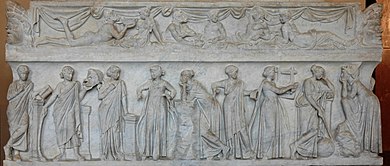Muse
From Wikipedia, the free encyclopedia
This article is about the goddesses. For other uses, see Muse (disambiguation).
The Muses (Ancient Greek: Μοῦσαι Mousai; perhaps from the o-grade of the Proto-Indo-European root *men-"think")[1] in Greek mythology, poetry and literature, are the goddesses of the inspiration of literature, science andthe arts. They were considered the source of the knowledge, related orally for centuries in the ancient culture, that was contained in poetic lyrics and myths.
The Muses, the personification of knowledge and the arts, especially literature, dance and music, are the nine daughters of Zeus and Mnemosyne (who was memorypersonified). Sometimes they are referred to as waternymphs, associated with the springs of Helicon and withPieris. According to Pausanias in the later 2nd century AD,[2] there were three original Muses, worshiped on Mount Heliconin Boeotia. In later tradition, four Muses were recognised: Thelxinoë, Aoedē, Arche, and Meletē, said to be daughters of Zeus and Plusia or of Uranus. In Renaissance and Neoclassical art, the dissemination of emblem books such as Cesare Ripa's Iconologia (1593 and many further editions) helped standardize the depiction of the Muses in sculpture and painting.
The Muses were both the embodiments and sponsors of performed metrical speech: mousike (hence the English term "music") was just "one of the arts of the Muses". Others included Science, Geography, Mathematics, Philosophy, and especially Art, Drama, and inspiration. Some authors invoke Muses when writing poetry, hymns or epic history. The invocation typically occurs at or near the beginning, and calls for help or inspiration, or simply invites the Muse to sing through the author. The British poet Robert Graves popularised the concept of the Muse-poet in modern times.[citation needed]His concept was based on pre-12th century traditions of the Celtic poets, the tradition of the medieval troubadours who celebrated the concept of courtly love, and the romantic poets.



